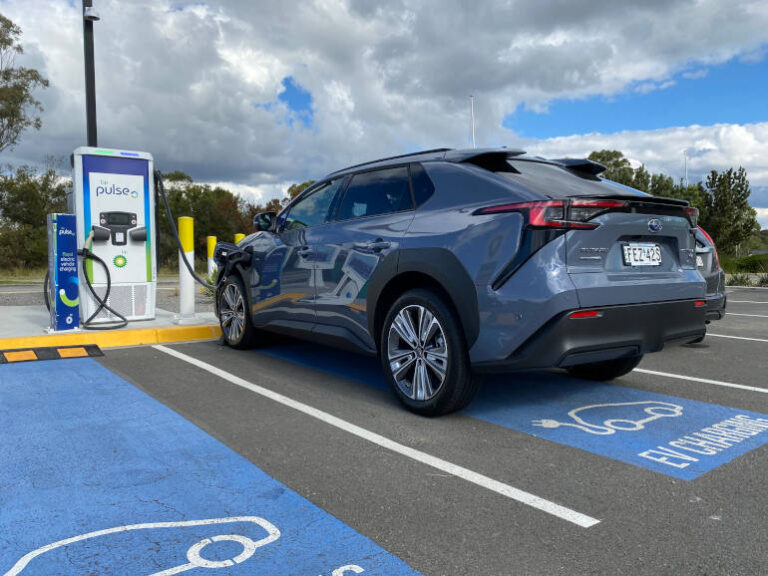It’s a Subaru which makes it a great car. The ground clearance is 212mm which makes it an option for fleet managers needing an EV for regional conditions (Prado is 219mm). But the published range doesn’t match my experience during the test drive.
Before we get to the range, what’s it like to drive? It’s great! There’s no complaints about the driving experience. From the comfortable seats to the ample storage and well laid out driver controls, it’s not quite an $80k experience but it’s a quality electric car.
There’s a quirkiness to the design of the dash and instrument cluster. Subaru have gone for a D shaped steering wheel which allows the driver to look over the wheel to see the 7 inch digital display. It’s a great way to eliminate the heads-up display and works well ergonomically.
The artistic approach towards the layout of the instrument cluster delivers a stylistic modern feel, but you also get a very large dashboard. This works as a design feature that creates a desirable aesthetic, and a perfect dust collection device. There’s no doubt that I could live in the Subaru Solterra everyday, but dusting the dashboard every week would be a chore for those of us that notice these things.
On the outside it looks conservative. You can tell it’s an EV because of the sharp angles and smooth front end (EVs don’t have a grille). It’s a modern design that won’t polarise buyers and will allow ICE owners to transition without becoming a beacon for the environment or climate change.
For Fleet Managers, the interior is similar to an ICE vehicle which will allow an easy driver induction when implementing a fleet EV transition. It could even work as a pool vehicle because of the simplicity. And there’s very little EV information in the infotainment system to confuse or dismay.
Now let’s talk about range. The Subaru Solterra comes with a 71.4 kWh Lithium-ion battery and an NEDC test range of 485km. I couldn’t replicate this distance while driving to Canberra from Sydney (300km at 110km/h), or driving around suburbia with an average speed of 30km/h.
I picked up the AWD Touring with 100% charge and 400km on the dash. I kept driving until the warning lights started flashing with 15% left in the battery. With the battery back at 89%, the range was only 336km (the equivalent of 377km with 100%). The final charge to 100% provided 379km in range.
This is the first time that I’ve driven an EV where the published range was so different to the actual range. The average electricity consumption was 5.4km per kWh. This means a 71.4 kWh battery (if you could use all of the battery) will allow you to drive 385km which is 20% less than the advertised range.
It’s not that I needed more range during the week I was in the Solterra. I didn’t even need the advertised 485km because there were plenty of opportunities to add some kms at public charging stations. It was the significant difference in expectations.
Most electric cars released in Australia so far have been built for Europe and tested under the WLTP which replaced the NEDC. A quick Google search revealed that the NEDC over estimates range by 25-30% which is what I experienced with the Subaru Solterra.
As the EV discussions mature, this is another area for Fleet Managers to consider when evaluating suitable vehicles for their fleet.
The WLTP system, introduced in 2017, is replacing the NEDC methodology. The newer WLTP procedures aim to test vehicles under conditions that are more realistic and better mimic on-road performance.
J.D. Power
These changes make the WLTP more accurate, with EV range estimates approximately 10% higher than what Europeans experience. Compare that to the NEDC’s tendency to overestimate by 25% to 30%.






